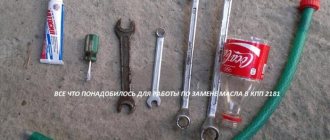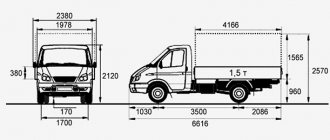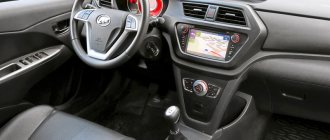Datsun on-DO is a budget front-wheel drive sedan, which was developed by AvtoVAZ together with Nissan on the Lada Granta platform. Serial production began in July 2014. We decided to compare the Datsun On Do and Lada Granta and identify the winner.
General characteristics
The model was equipped with 1.6L VAZ engines:
- 8-valve - 82 hp,
- 8-valve with lightweight piston group - 87 hp.
- 16-valve with a lightweight piston group and a modified intake manifold - 106 hp.
As for the transmission, options with a classic 5-speed manual transmission were possible; a little later the Japanese 4-speed “automatic” Jatco was added to production. The 106-horsepower engine is only available as a manual transmission due to the fact that the automatic was not designed for that amount of horsepower.
Three configurations were presented: Access, Trust, Dream.
The following were already available as standard:
- Anti-lock braking system, ABS;
- Brake Assist, BAS;
- Electronic Brake Force Distribution, EBD;
- Driver airbag;
- Heated front seats;
- Electric power steering.
In other trim levels you can see options such as:
- Electric windows;
- Heated windshield;
- Climate control;
- 2-DIN multimedia system (in the TOP - with navigation);
- Rain and light sensors.
But none of the trim levels include such familiar TOP things as leather interior and cruise control. Air conditioning is found only in higher trim levels.
Equipment and prices
In terms of equipment, Priora and Mi-Do are almost equal, differing only in nuances. Moreover, a similar trend is observed both in the initial versions and in the top ones.
Base
The basic configurations of rivals are frankly not rich, and each brand has gone its own way. Thus, the Japanese relied on safety - against only one airbag that the Lada has, as well as the ABS and EBA systems, they have a similar set, supplemented by the EBD system.
The interior of the VAZ model looks good in any configuration.
And in terms of comfort, Priora is ahead - while Datsun only has heated front seats, the domestic model also boasts electric drive of mirrors and front windows. Also, the buyer of a Priora will immediately have an alarm with an immobilizer and central locking (with remote control). On-Do can only counteract with an immobilizer.
Even in the base version, the Datsun is quite pretty.
Regarding the cost, the Lada’s is significantly higher – 435,000 rubles. versus RUB 376,000 But this is justified by a more powerful power unit.
Top performance
As for the top modifications, the list of equipment is almost identical. Thus, both models have front and side airbags, ISOFIX fastenings, seat belt pretensioners, and also electronics (ABS and EBA). Comfort is provided by an adjustable steering wheel, full power accessories, rear parking sensors, rain and light sensors, climate control, heated seats, mirrors and glass, Bluetooth, navigation and a color display.
One of the “chips” of the Priora is its lighting.
Among the differences, we can point out the different diameter of the alloy wheels - 14 inches for the Priora and 15 for the Datsun. The Japanese is able to offer a more complete set of safety equipment, complete with ESP and EBD systems, while Priora offers turn signal repeaters in the mirrors and cruise control.
The top version with a display looks much more presentable.
The price tag for the top version of the Datsun is 492,000 rubles, which is only slightly less than the 526,000 rubles that are asked for the Priora.
Cons and pros
Among the advantages, car owners note:
- Strong chassis and reliable suspension;
- Economical. Mixed gasoline consumption for an 87 hp engine. — 7 liters per hundred.
- Large ground clearance;
- Spacious trunk of 530 liters;
- Cheap and accessible spare parts, almost everything comes from Granta;
- Japanese automatic transmission of good quality.
The disadvantages usually include:
- Poor sound insulation;
- Poor paintwork, the body is not galvanized - it rusts on chips;
- Gearbox noise. In 1st and 3rd gear the manual transmission hums;
- The high cost of some spare parts that do not match the Grant;
- Poor quality of interior finishing materials;
- Weak factory wheel bearings, change already at 30t.km;
- “Sailage” from a side wind when driving on a highway.
It turns out that there are more minuses than pluses. Let's look at the price.
Lada Granta
In 2011, AvtoVAZ began production of the Granta, built on the basis of the already well-known Lada Kalina.
The model was intended to finally replace the entire “classic”, as well as the Lada “Samara” line and even the “Kalina” itself.
It was assumed that the new Granta should not differ much in price from its predecessors, but the difference was still felt. This was due to new comfort and equipment with modern systems.
The main component of the increase in price of the model was the introduction of a mandatory driver airbag in all trim levels and modification of engines for Euro-4. These are inevitable steps on the path to modernity.
General characteristics
There are several body styles: sedan, hatchback and sport. If everything is clear with the first two, then the Lada Granta Sport variation was new to the Russian buyer. The main differences were brake discs with an increased diameter for greater control over braking during sharp maneuvers, reduced by 20mm. ground clearance, stiffer shock absorbers and low-profile tires.
Variations of the 1.6l engine. larger volume than Datsun on-DO .
- 8-valve - 82 hp
- 8-valve with lightweight piston group - 87 hp.
- 16-valve with lightweight piston group - 98 hp.
- 16-valve with a lightweight piston group and a modified intake manifold - 106 hp.
- 16-valve with a lightweight piston group and a modified timing system - 118 hp. for the “Sport” package.
There are several trim levels: Classic, Standard, Comfort, Luxe. There are also subcategories that expand the range of options.
In basic versions:
- Anti-lock braking system, ABS;
- Brake Assist, BAS;
- Electronic Brake Force Distribution, EBD;
- Driver airbag;
- Electric power steering;
- On-board computer;
- Standard immobilizer;
- Air conditioner;
- Front electric windows.
But heated front seats are not included as standard.
Leather upholstery and cruise control are missing from either trim level, just like the Datsun on-DO.
Since September 2020, the updated second-generation Granta has been produced. The following body styles will be available: sedan, hatchback, liftback, station wagon. A robotic 5-speed gearbox will be added to the Japanese automatic transmission.
Engines of Lada Granta and Datsun on-Do
In this regard, the Granta has a noticeable advantage, since its line of power units includes 4 units, while the On-Do has only 2. 1.6-liter engines, the power of which is estimated at 82 hp, are common to both models. With. and 87 l. With.
Datsun borrowed only the weakest engines from VAZ models.
The first of these engines is 8-valve, with peak output reaching 5,100 rpm for both units. These are simple aspirated in-line engines equipped with an injector. Regarding traction, the 82-horsepower engine produces 132 Nm at 3,800 rpm, and the 87-horsepower engine produces 140 “newtons” at the same 3,800 rpm. This is where the variety of engines on He-Do ends.
With top-end power units, Grant is noticeably more powerful than its rival.
But Granta is able to offer noticeably more powerful in-line “fours” - with an output of 98 hp. With. at 5,600 rpm (with a thrust of 145 Nm at 4,000 rpm) and 106 hp. With. at 5,800 rpm and with 148 Nm of torque at the same 4,000 rpm. As you can see, Grant is confidently beaten by Datsun in this category - a large range of engines guarantees the buyer a wide choice. And the presence of powerful engines is important.
Cons and pros
Pros according to reviews from car owners:
- Good, energy-intensive, indestructible suspension;
- Large trunk of 520 liters, but 10 less than the Datsun;
- Nice, warm stove;
- Cheap and available spare parts;
- Maintainability, any service will take on the job;
- Low fuel consumption, about 7l. per hundred for manual transmission and 87 hp;
- Large ground clearance, convenient for parking;
- Japanese automatic transmission of good quality, reliable;
The disadvantages include:
- Reverse gear on a manual transmission sometimes does not engage the first time; you need to press the clutch again;
- Poor sound insulation;
- Poor paintwork - rusts on chips;
- Weak wheel bearings from the factory;
- Cheap, squeaky plastic;
Comparison of models
Datsun on-DO is a project of the Japanese concern Nissan, developed specifically for the Russian market. It is worth noting that this is the first car under a foreign brand, built on the platform of a domestic manufacturer. The basic design of the Lada Granta/Kalina was used as the basis for the new model, but this does not mean that the on-DO is identical in its characteristics to the Granta.
Japanese engineers increased the dimensions of the car, developed a unique interior and design, and also improved problematic issues in the technical “stuffing”. Despite the fact that on-DO and Granta are assembled on the same assembly line in Togliatti, Datsun cars undergo a separate quality control system, which guarantees their higher reliability and durability.
Thus, Nissan managed to create a serious competitor for one of the leaders in the budget sedan segment in Russia - the Lada Priora model. The machines are comparable in cost and size, and are equal in many technical and ergonomic indicators. One of the few points in which Priora has superiority is engine power (ICE modifications of 98 and 106 hp versus 82 and 87 hp for the on-DO model). At the same time, Datsun responds by having an automatic transmission in advanced configuration options versus the less reliable robotic gearbox of the Russian car.
With an identical set of equipment and options, the “Japanese” surpasses the “Priora” in terms of safety (thanks to the presence of EBD and ESP systems), quality of noise insulation, and suspension stability. In addition, on-DO offers such advantages as a more spacious trunk (530 liters versus 444 for Lada), larger wheel diameter (15 inches versus 14) and, which is especially important in Russian operating conditions, increased ground clearance (174 mm versus 165).
Who is cooler: Datsun on-DO or Lada Granta
Both models are in fact made in Russia. Built on the same platform, they have common engines, transmission and suspension. The breakdowns are almost identical, pluses and minuses too.
However, in terms of the external design of the body, the Datsun clearly wins. The pronounced sharp edges of the front part, the embossed hood, the interesting radiator grille - all this leaves the Grant behind.
In terms of interior design, Datsun also wins. Its interior is more “advanced” and functional. And in Granta, the “lamb” controls for the stove still migrate from model to model, just like on the “classic”.
Lada Granta has an undeniable advantage in the variety of bodies from sedan and hatchback to station wagon, while Datsun on-DO is content with only one sedan body.
In addition to this, “Granta” earns additional points for the recent release of the second generation - this means that AvtoVAZ does not stand still, is improving, adding “robot” to “mechanics” and “automatic” - everything to satisfy even sophisticated buyers.
Look like brothers
With the advent of the new Japanese subcompact Datsun on-DO, the domestic buyer faced a dilemma: should he give his preference to a semi-foreign car or opt for the VAZ Lada Granta? In this review, we will try to determine which of them - Datsun or Granta - will prevail on the vast expanses of Russian highways in the near future.
Datsun on-DO and Lada Granta cars - are they the same in everything?
The thing is that when creating Datsun on-DO, it was Granta that was taken as the basis. It should be understood that they do not have such big differences, especially from the technical side. Although, of course, each of them has individual characteristics. A detailed examination of each of the characteristics will help us understand how the Datsun differs from the Granta.











